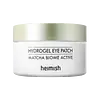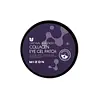What's inside
What's inside
 Key Ingredients
Key Ingredients

 Benefits
Benefits

 Concerns
Concerns

 Ingredients Side-by-side
Ingredients Side-by-side

Water
Skin ConditioningGlycerin
HumectantCarrageenan
Niacinamide
SmoothingCamellia Sinensis Leaf Extract
AntimicrobialCeratonia Siliqua Gum
EmollientPentylene Glycol
Skin ConditioningCaprylyl Glycol
EmollientLavandula Angustifolia Flower Extract
CleansingMonarda Didyma Leaf Extract
Skin ConditioningCyamopsis Tetragonoloba Gum
Emulsion StabilisingMentha Piperita Leaf Extract
Skin ConditioningFreesia Refracta Extract
Skin ConditioningChamomilla Recutita Flower Extract
MaskingRosmarinus Officinalis Leaf Extract
AntimicrobialLactobacillus Ferment
Skin ConditioningSaccharomyces Ferment
Skin ConditioningPaeonia Lactiflora Root Extract
Skin ConditioningGlycyrrhiza Glabra Root Extract
BleachingPolygonum Multiflorum Root Extract
Skin ConditioningPhellinus Linteus Extract
Skin ConditioningMorus Alba Bark Extract
Skin ConditioningSophora Angustifolia Root Extract
Skin ConditioningCimicifuga Racemosa Root Extract
AntimicrobialSesamum Indicum Seed Extract
Skin ConditioningAngelica Gigas Root Extract
Skin ConditioningScutellaria Baicalensis Root Extract
AstringentCitrus Nobilis Peel Extract
MaskingCupressus Sempervirens Leaf/Stem Extract
Skin ConditioningHedera Helix Leaf/Stem Extract
AntimicrobialCitrus Aurantium Bergamia Fruit Oil
MaskingLitsea Cubeba Fruit Oil
MaskingRibes Nigrum Leaf Extract
PerfumingButylene Glycol
HumectantEthyl Hexanediol
SolventHexylene Glycol
EmulsifyingRicinus Communis Seed Oil
MaskingPropanediol
SolventPinus Sylvestris Leaf Extract
TonicPolyglyceryl-10 Laurate
Skin ConditioningCalcium Chloride
AstringentAllantoin
Skin ConditioningCellulose Gum
Emulsion Stabilising1,2-Hexanediol
Skin ConditioningChromium Oxide Greens
Potassium Chloride
Hydroxyacetophenone
AntioxidantIllicium Verum Fruit Extract
PerfumingSucrose
HumectantChlorphenesin
AntimicrobialCalcium Lactate
AstringentDipotassium Glycyrrhizate
HumectantTitanium/Titanium Dioxide
Cosmetic ColorantSynthetic Fluorphlogopite
Adenosine
Skin ConditioningTitanium Dioxide
Cosmetic ColorantPolymethylsilsesquioxane
Silica
AbrasivePolyglyceryl-10 Oleate
Skin ConditioningArginine
MaskingEthylhexylglycerin
Skin ConditioningDisodium EDTA
Water, Glycerin, Carrageenan, Niacinamide, Camellia Sinensis Leaf Extract, Ceratonia Siliqua Gum, Pentylene Glycol, Caprylyl Glycol, Lavandula Angustifolia Flower Extract, Monarda Didyma Leaf Extract, Cyamopsis Tetragonoloba Gum, Mentha Piperita Leaf Extract, Freesia Refracta Extract, Chamomilla Recutita Flower Extract, Rosmarinus Officinalis Leaf Extract, Lactobacillus Ferment, Saccharomyces Ferment, Paeonia Lactiflora Root Extract, Glycyrrhiza Glabra Root Extract, Polygonum Multiflorum Root Extract, Phellinus Linteus Extract, Morus Alba Bark Extract, Sophora Angustifolia Root Extract, Cimicifuga Racemosa Root Extract, Sesamum Indicum Seed Extract, Angelica Gigas Root Extract, Scutellaria Baicalensis Root Extract, Citrus Nobilis Peel Extract, Cupressus Sempervirens Leaf/Stem Extract, Hedera Helix Leaf/Stem Extract, Citrus Aurantium Bergamia Fruit Oil, Litsea Cubeba Fruit Oil, Ribes Nigrum Leaf Extract, Butylene Glycol, Ethyl Hexanediol, Hexylene Glycol, Ricinus Communis Seed Oil, Propanediol, Pinus Sylvestris Leaf Extract, Polyglyceryl-10 Laurate, Calcium Chloride, Allantoin, Cellulose Gum, 1,2-Hexanediol, Chromium Oxide Greens, Potassium Chloride, Hydroxyacetophenone, Illicium Verum Fruit Extract, Sucrose, Chlorphenesin, Calcium Lactate, Dipotassium Glycyrrhizate, Titanium/Titanium Dioxide, Synthetic Fluorphlogopite, Adenosine, Titanium Dioxide, Polymethylsilsesquioxane, Silica, Polyglyceryl-10 Oleate, Arginine, Ethylhexylglycerin, Disodium EDTA
Water
Skin ConditioningGlycerin
HumectantChondrus Crispus Extract
Skin ConditioningCeratonia Siliqua Gum
EmollientCellulose Gum
Emulsion StabilisingHydroxyacetophenone
Antioxidant1,2-Hexanediol
Skin ConditioningSucrose
HumectantPotassium Chloride
Allantoin
Skin ConditioningXanthan Gum
EmulsifyingEthylhexylglycerin
Skin ConditioningCalcium Aluminum Borosilicate
CI 77007
Cosmetic ColorantAdenosine
Skin ConditioningBis-PEG-15 Methyl Ether Dimethicone
EmulsifyingDisodium EDTA
Calcium Lactate
AstringentCI 77891
Cosmetic ColorantSilica
AbrasiveMica
Cosmetic ColorantHydrolyzed Collagen
EmollientDipotassium Glycyrrhizate
HumectantSodium Polyacryloyldimethyl Taurate
Emulsion StabilisingPolyglyceryl-4 Caprate
EmulsifyingPolyglyceryl-6 Caprylate
EmulsifyingDipalmitoyl Hydroxyproline
Skin ConditioningPEG-60 Hydrogenated Castor Oil
EmulsifyingButylene Glycol
HumectantPalmitic Acid
EmollientParfum
MaskingPortulaca Oleracea Extract
Skin ConditioningChamomilla Recutita Flower Extract
MaskingCaviar Extract
Skin ConditioningPhenoxyethanol
PreservativeTocopherol
AntioxidantWater, Glycerin, Chondrus Crispus Extract, Ceratonia Siliqua Gum, Cellulose Gum, Hydroxyacetophenone, 1,2-Hexanediol, Sucrose, Potassium Chloride, Allantoin, Xanthan Gum, Ethylhexylglycerin, Calcium Aluminum Borosilicate, CI 77007, Adenosine, Bis-PEG-15 Methyl Ether Dimethicone, Disodium EDTA, Calcium Lactate, CI 77891, Silica, Mica, Hydrolyzed Collagen, Dipotassium Glycyrrhizate, Sodium Polyacryloyldimethyl Taurate, Polyglyceryl-4 Caprate, Polyglyceryl-6 Caprylate, Dipalmitoyl Hydroxyproline, PEG-60 Hydrogenated Castor Oil, Butylene Glycol, Palmitic Acid, Parfum, Portulaca Oleracea Extract, Chamomilla Recutita Flower Extract, Caviar Extract, Phenoxyethanol, Tocopherol
 Reviews
Reviews

Ingredients Explained
These ingredients are found in both products.
Ingredients higher up in an ingredient list are typically present in a larger amount.
1,2-Hexanediol is a synthetic liquid and another multi-functional powerhouse.
It is a:
- Humectant, drawing moisture into the skin
- Emollient, helping to soften skin
- Solvent, dispersing and stabilizing formulas
- Preservative booster, enhancing the antimicrobial activity of other preservatives
Adenosine is in every living organism. It is one of four components in nucleic acids that helps store our DNA.
Adenosine has many benefits when used. These benefits include hydrating the skin, smoothing skin, and reducing wrinkles. Once applied, adenosine increases collagen production. It also helps with improving firmness and tissue repair.
Studies have found adenosine may also help with wound healing.
In skincare products, Adenosine is usually derived from yeast.
Learn more about AdenosineAllantoin is a soothing ingredient known for its protective and moisturizingg properties. Because of this, it is often added to products with strong active ingredients.
Studies show higher concentrations of this ingredient can promote wound healing.
Though it can be derived from the comfrey plant, allantoin is produced synthetically for cosmetic products to ensure purity.
Learn more about AllantoinButylene Glycol (or BG) is used within cosmetic products for a few different reasons:
Overall, Butylene Glycol is a safe and well-rounded ingredient that works well with other ingredients.
Though this ingredient works well with most skin types, some people with sensitive skin may experience a reaction such as allergic rashes, closed comedones, or itchiness.
Learn more about Butylene GlycolCalcium Lactate is created by combining lactic acid with calcium carbonate or calcium hydroxide.
Cellulose Gum is a water-soluble polymer that comes from cellulose. It is used to change the texture of a product and to help stabilize emulsions.
As an emulsifier, cellulose gum specifically thicken the texture of water-based products.
This ingredient is considered hypoallergenic and non-toxic. Cellulose Gum can be found in cosmetics, food, and other household goods such as paper products.
Learn more about Cellulose GumCeratonia Siliqua Gum is extracted from the seeds of the carob tree. You might know this ingredient as Carob Gum or Locust Bean Gum. It is used to stabilize other ingredients and improve the texture of products.
Carob gum is made up of long-chain polysaccharides. This makes it a natural thickener.
Yes! This ingredient comes from the seeds of a tree. The name 'Locust Bean Gum' can be misleading.
Learn more about Ceratonia Siliqua GumChamomilla Recutita Flower Extract comes from the Chamomile flower.
Chamomile is rich in antioxidants and has anti-inflammatory properties. Several compounds found in chamomile help with soothing, such as bisbolol.
Antioxidant components in chamomile make it an effective ingredient to help slow the signs of aging. Antioxidants help fight free-radical molecules, or molecules that may damage your skin.
Essential oils from chamomile have been found to improve wound healing due to its antimicrobial properties.
Ancient Greeks and Egyptians used Chamomile to treat skin redness and dryness. Chamomile has also been used to help treat stomach issues.
Learn more about Chamomilla Recutita Flower ExtractDipotassium Glycyrrhizate comes from licorice root.
Extracts of licorice have demonstrated to have antibacterial, anti‐inflammatory, antiviral, antioxidant properties.
One component, glabridin, has extra potent antioxidant and soothing properties. It has also been found to block pigmentation from UVB rays in guinea pigs.
Licorice Root also contains a flavonoid. Flavonoids are a natural substance from in plants. Flavonoids also have antioxidant properties.
Another component, glycyrrhizin, has been found to have anti-inflammatory and antimicrobial benefits. This may make licorice root extract effective at treating acne. However, more research is needed to support this.
Liquiritin is one of the flavone compounds found in licorice. It has been found to help lighten skin by preventing tyrosinase from reacting with tyrosine. When the two react, protein is converted to melanin. Melanin is the substance in your body that gives your features pigmentation.
Licorice root is native to Southern Europe and Asia. It has been used in traditional Chinese medicine to help with respiratory issues.
Learn more about Dipotassium GlycyrrhizateDisodium EDTA plays a role in making products more stable by aiding other preservatives.
It is a chelating agent, meaning it neutralizes metal ions that may be found in a product.
Disodium EDTA is a salt of edetic acid and is found to be safe in cosmetic ingredients.
Learn more about Disodium EDTAEthylhexylglycerin (we can't pronounce this either) is commonly used as a preservative and skin softener. It is derived from glyceryl.
You might see Ethylhexylglycerin often paired with other preservatives such as phenoxyethanol. Ethylhexylglycerin has been found to increase the effectiveness of these other preservatives.
Glycerin is already naturally found in your skin. It helps moisturize and protect your skin.
A study from 2016 found glycerin to be more effective as a humectant than AHAs and hyaluronic acid.
As a humectant, it helps the skin stay hydrated by pulling moisture to your skin. The low molecular weight of glycerin allows it to pull moisture into the deeper layers of your skin.
Hydrated skin improves your skin barrier; Your skin barrier helps protect against irritants and bacteria.
Glycerin has also been found to have antimicrobial and antiviral properties. Due to these properties, glycerin is often used in wound and burn treatments.
In cosmetics, glycerin is usually derived from plants such as soybean or palm. However, it can also be sourced from animals, such as tallow or animal fat.
This ingredient is organic, colorless, odorless, and non-toxic.
Glycerin is the name for this ingredient in American English. British English uses Glycerol/Glycerine.
Learn more about GlycerinHydroxyacetophenone is antioxidant with skin conditioning and soothing properties. It also boosts the efficiency of preservatives.
This ingredient is not irritating or sensitizing.
Potassium Chloride can be bad for oily skin and be bad for acne prone skin.
Silica, also known as silicon dioxide, is a naturally occurring mineral. It is used as a fine, spherical, and porous powder in cosmetics.
Though it has exfoliant properties, the function of silica varies depending on the product.
The unique structure of silica enhances the spreadability and adds smoothness, making it a great texture enhancer.
It is also used as an active carrier, emulsifier, and mattifier due to its ability to absorb excess oil.
In some products, tiny microneedles called spicules are made from silica or hydrolyzed sponge. When you rub them in, they lightly polish away dead skin layers and enhance the penetration of active ingredients.
Learn more about SilicaSucrose is a natural sugar found in fruits, vegetables, and nuts. It is the main constituent of white sugar.
In skincare, sucrose is a humectant and can be a mild exfoliant.
Sucrose is hydrophilic, meaning it attracts water. This makes it an effective humectant and helps hydrate the skin.
Studies show sugars may worsen acne-prone skin due to it disrupting the skin's natural biome. We recommend speaking with a professional if you have any concerns.
In some products such as body scrubs, sucrose is used as an gentle exfoliant.
The term 'sucrose' comes from the french word for sugar, 'sucre'.
Learn more about SucroseWater. It's the most common cosmetic ingredient of all. You'll usually see it at the top of ingredient lists, meaning that it makes up the largest part of the product.
So why is it so popular? Water most often acts as a solvent - this means that it helps dissolve other ingredients into the formulation.
You'll also recognize water as that liquid we all need to stay alive. If you see this, drink a glass of water. Stay hydrated!
Learn more about Water